Progression in Assistive Technology
14/12/2017
Exciting Advancements in Assistive Technology
Advancements in technology are happening all the time at a dramatic rate in the general world population and also specifically in relation to disabled people. Our Chief Executive mentioned recently that a new, updated model of a vehicle now included Amazon’s Alexa intelligent assistant as the in-flight command option, so the days of attempting to gently request our in-car system to call someone by name to then have to eventually resort to expletives because it calls Joe instead of Jeff may be behind us. But what does this advancement mean for disabled people, and how can these developments contribute to independent living?
At the start of the year, I wrote about pieces of technology that seemed quite cutting edge at the time, so I thought I would use this post to revisit some of that tech and see where they are nearly 12 months on.
NFC Helps Me make a selection of easy-to-follow instructional videos, which assist those with special needs to live independently. The technology uses an NFC sticker, which you can scan, and a video is provided on a task, such as washing, making toast, or boiling the kettle, thus contributing to independent living. NFC has certainly moved forward in the past year in taking that next leap to independence by providing instructional videos in the same way to support people in employment learn tasks, providing a step-by-step guide on tasks such as making coffee in a coffee shop or operating a pallet truck in a warehouse.
Thankfully the work that NFC Helps Me are doing will help to ensure that employers don’t miss out on amazing talent. It also brings some comfort to Disability Action Yorkshire as a charity because a lot of the work we do within our learning environment is aimed at helping disabled people to access employment opportunities, and we have a great team who are pushing to realise that aim. NFC Helps Me are currently leading a campaign to get more employers to employ people with additional needs, and you can follow the movement on Twitter with this hashtag #DontDisMyAbility

Next is 3D printing, and what a progression! When I spoke at the start of the year, I mentioned a wheelchair joystick that could be printed, saving hundreds of pounds for a disabled person, so what about now? Well, the capabilities of 3D printing have grown significantly, and I think that one of the most fascinating things to be developed is 3D printed prosthetic limbs. Open Bionics is an organisation in the UK that is really revolutionising the industry. Fortunately, it is going through clinical trials with the NHS with the aim of providing 3D-printed bionic arms and has been granted a second-stage contract that includes product development. Essentially what this means is that Open Bionics have brought the NHS one step closer to being able to offer 3D printed prosthetic limbs.

Last but by no means least is Amazon Echo. It seems that over the past twelve months, companies have been scrambling around to create ‘skills’ for this much-loved device. Below, I list a few skills that can assist in creating peace of mind when living independently.
- One example is ‘Ask My Buddy,‘ which acknowledges that sometimes you can fall when alone and it can be difficult to get to a phone or press a button for assistance. With one command, ‘Alexa, Ask My Buddy to alert a contact,’ you can notify someone or everyone in your personal alert network, advising them to check on you right away.
- Ring is a video doorbell that I have had the opportunity to test. It works with the new Amazon Echo Show or Fire Stick to show you who is at your door. The motion-activated device ensures that you won’t have to miss a visitor if it usually takes you a little longer to answer the door, and the two-way audio allows you to tell the caller that you might be a few minutes getting to them. In addition, if it is a bogus caller, you can choose to ignore or simply say that you are not interested. All media recorded is stored for 30 days, so you can see any missed callers or, alternatively, report suspicious characters.

- To complement the Ring doorbell, I would like to see a smart door lock that lets you say ‘Alexa, open front door,’ or something to that effect. Although Yale developed a smart lock that allows you to check the status of a door or lock it, there isn’t really anything with a suitable unlock function. I was reading about a gentleman in America who kitted out his whole home with various smart devices connected to a home hub similar to the Amazon Echo. When a neighbour came to the front door and simply shouted ‘Open, door,’ he was able to gain access to the house. Clearly, before locks complement devices such as Echo, the security needs to be robust enough to protect us from intruders.
The market for these voice-controlled intelligent personal assistants is becoming increasingly competitive, with Google bringing their own version, named Google Home, and Apple with Siri, which works through Apple TV but is not quite as sophisticated as the others (in my opinion), although one of our charity trustees mentioned a version similar to Alexa, and home will soon be upon us.
We are interested to hear about how you use the Amazon Echo or any other device that contributes towards independent living in your home. You can share your stories by following clicking here.